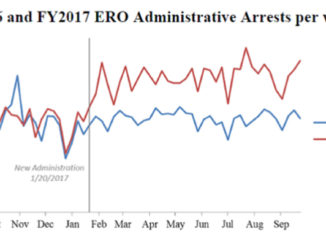
by Alex Nowrasteh and David Bier
A critical element of any future immigration reform will be the legalization of illegal immigrants. Previous immigration reform proposals have failed, largely because policymakers disagreed over whether and how to legalize illegal immigrants. Future immigration reform proposals must be different from previous proposals if there is any hope of them becoming law.
Presently, there are about 10-12 million illegal immigrants who reside in the United States, are unable to legally work, and are thus uncertain about their futures. Almost 17 million people live in families with at least one illegal immigrant in the household, representing 4.6 percent of the U.S. population.1 Because of labor market regulations that outlaw the employment of illegal immigrants, they face an estimated wage penalty of 11.3 percent relative to legal immigrants.2 Granting legal status to illegal immigrants will help solve these and other issues.
Past legalization reforms introduced by members of Congress were too similar to one another. They all failed, so it is time for Congress to propose new means of legalizing immigrants who are living here illegally. Our proposals provide three such means for legalizing illegal immigrants that will overcome some of the main political objections in the past. These proposals are very different from past proposals, and will create a better system:
- Legalizing immigrants through a tiered system, whereby illegal immigrants can choose to either be legalized quickly and cheaply without the ability to gain citizenship in the future or begin a lengthier and expensive path toward citizenship;
- Rolling legalization by allowing long-term illegal immigrant residents to legalize their status on an ongoing basis without an application cutoff date; and
- Slowing chain immigration by limiting legalized immigrants’ ability to sponsor family members from overseas for lawful permanent residency (LPR) or green cards.
These proposals address the issue in different ways, but all do so from the perspective that the majority of the 10-12 million illegal immigrants should be legalized. These proposed policies are also not mutually exclusive because Congress could enact all of them together to form a coherent policy. None of these proposals are ideal, and they are all compromises, but neither side in this political debate is going to get everything it wants, so middle-ground proposals are necessary if either side is going to receive some partial resolution to this pressing problem. We write this brief with the hope that at least one of these proposals will be innovative and effective enough to break the congressional logjam over legalization.
Some opponents of legalization or amnesty fear that family sponsorship, or the “chain-migration system,” is either unfair or would unreasonably expand legal immigration.24 There is a long-running debate over the family sponsorship portion of the immigration system, but limiting the ability of legalized immigrants to sponsor their family members addresses this fear. In 1982, Congress passed the Virgin Islands Nonimmigrant Alien Adjustment Act to allow some temporary immigrant workers in those islands to earn LPR status.25 Congress inserted a unique provision in that law that prevented the immigrants affected by this bill from using their LPR status or eventual citizenship from sponsoring additional relatives.26 The risk of that type of ban on a larger population is that preventing family reunification in the United States could incentivize more illegal immigration in the future as family members seek to reunify with their legalized relatives here. The risk of increased illegal immigration could be reduced substantially by allowing the amnestied immigrants to sponsor their spouses and minor children only.
Restricting the ability of U.S. citizens to sponsor their family members if they were legalized under amnesty is likely unconstitutional, according to the Equal Protection Clause of the Fourteenth Amendment.27 Thus Congress would likely have to grant amnestied immigrants a legal-but-less-than-citizenship permanent status for this provision to pass constitutional muster. Another option would be for Congress to prevent amnestied immigrants from sponsoring their family members for a visa while they are on LPR status, and then to extend that LPR status longer than the current five years of residency that are required before applying for naturalization. Since Congress already restricts noncitizen sponsorship of immigrants, this would likely not violate the Equal Protection Clause.
Conclusion
Although Congress has passed several amnesties for illegal immigrants since the early 20th century, not one of its major efforts to legalize or amnesty illegal immigrants has succeeded in recent decades.28 Part of the reason for their failure is that proponents of legalization and immigration reform have not presented new or innovative ways to legalize this population while accounting for the criticisms and worries of opponents. The three proposals included in this brief—tiered legalization, rolling legalization, and limiting chain migration for legalized immigrants—are all compromise policies that are less than ideal, but they are an attempt to supply new ideas so that Congress will be able to break the reform deadlock and legalize illegal immigrants.
Notes
1. Paul Taylor et al., “Unauthorized Immigrants: Length of Residency, Patterns of Parenthood,” Pew Research Center, December 1, 2011.
2. Andrew Forrester and Alex Nowrasteh, “Immigrant Wages Converge with Those of Native-Born Americans,” Cato Institute Immigration and Research Policy Brief no. 9, October 4, 2018.
3. Dan Griswold, “Willing Workers: Fixing the Problem of Illegal Mexican Migration to the United States,” Cato Institute Trade Policy Analysis no. 19, October 15, 2002, p. 19.
4. Alex Nowrasteh, “Path toward Citizenship or Legalization,” The Hill, August 30, 2013; Andorra Bruno et al., “Immigration Legislation and Issues in the 113th Congress,” Congressional Research Service, November 4, 2014; Congressional Budget Office, “S. 744 Border Security, Economic Opportunity, and Immigration Modernization Act,” June 18, 2013.
5. Alex Nowrasteh, “Ted Cruz’s Mixed Record on Immigration Reform,” Cato at Liberty (blog), November 13, 2015.
6. Alex Nowrasteh, “One Solution to the Immigration Debate,” Washington Examiner, August 19, 2015.
7. Alex Nowrasteh, “Immigration Reform Is Not Amnesty,” Cato at Liberty (blog), July 23, 2013.
8. “S. 744 Border Security, Economic Opportunity, and Immigration Modernization Act,” Congressional Budget Office Cost Estimate, June 18, 2013, p. 14.
9. Bryan C. Baker, “Naturalization Rates among IRCA Immigrants: A 2009 Update,” Department of Homeland Security Fact Sheet, October 2010.
10. Nowrasteh, “Immigration Reform.”
11. The Immigration Reform and Control Act (IRCA), Pub.L. 99-603, 100 Stat. 3445, enacted November 6, 1986.
12. 8 U.S.C. § 1229b. Cancellation of removal; adjustment of status.
13. 8 U.S.C. § 1229b(e)(4).
14. 8 CFR § 274a.12(c).
15. “Non-LPR Cancellation of Removal,” Immigrant Legal Resource Center, June 2018.
16. Suspension of Deportation, 8 U.S.C. § 1254 (1994); U.S. Department of Justice, Executive Office for Immigration Review, “Application for Suspension of Deportation,” July 2015.
17. 8 U.S.C. § 3361.
18. GOV.UK, “Immigration Rules Part 7: Other Categories,” ¶ A246-276BVI.
19. GOV.UK, “Immigration,” ¶ A246-276BVI.
20. GOV.UK, “Immigration,” ¶ 276DE.
21. Tal Kopan and Jennifer Agiesta, “CNN/ORC Poll: Americans Break with Trump on Immigration Policy,” CNN, March 17, 2017; Brad Lendon, “U.S. Prepares for ‘A Day without an Immigrant,’” CNN, May 1, 2006.
22. Jeffrey Passel and D’Vera Cohn, “Unauthorized Immigrants Are More Likely to Be Long-Term Residents,” in U.S. Unauthorized Immigrant Total Dips to Lowest Level in a Decade, Pew Research Center, November 28, 2018.
23. Department of Homeland Security, 2017 Yearbook of Immigration Statistics, Office of Immigration Statistics, Table 6.
24. See Jessica M. Vaughan, “Immigration Multipliers: Trends in Chain Migration,” Center for Immigration Studies Backgrounder, September 27, 2017.
25. H.R. 3517, 97th Cong. (1982).
26. Vernon M. Briggs Jr., Immigration Policy and the American Labor Force (Baltimore: Johns Hopkins University Press, 1984), p. 110.
27. Alex Nowrasteh and Sophie Cole, “Building a Wall around the Welfare State, Instead of the Country,” Cato Institute Policy Analysis no. 732, July 25, 2013, pp. 14-16.
28. Alex Nowrasteh, “Legalization or Amnesty for Unlawful Immigrants—An American Tradition,” Cato at Liberty (blog), July 28, 2014.



